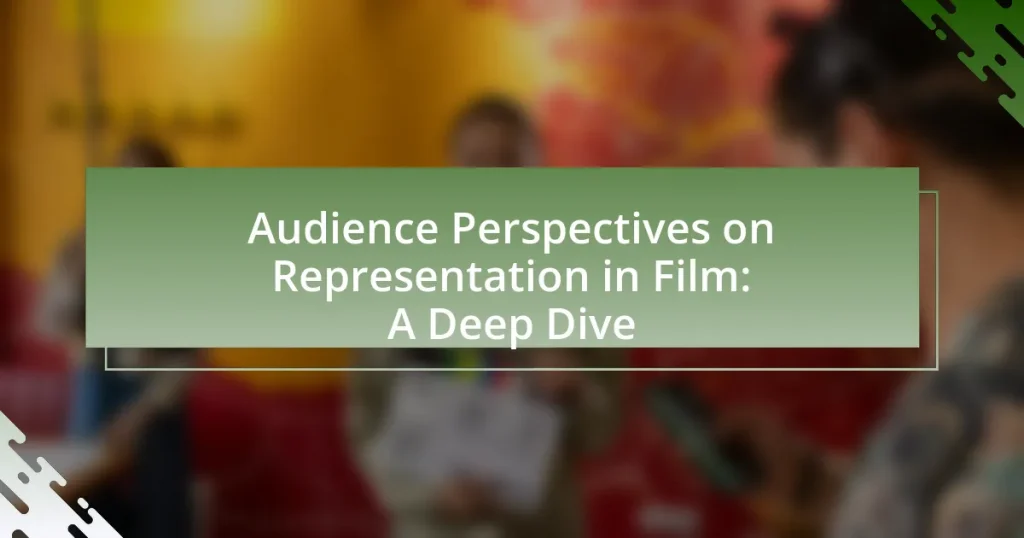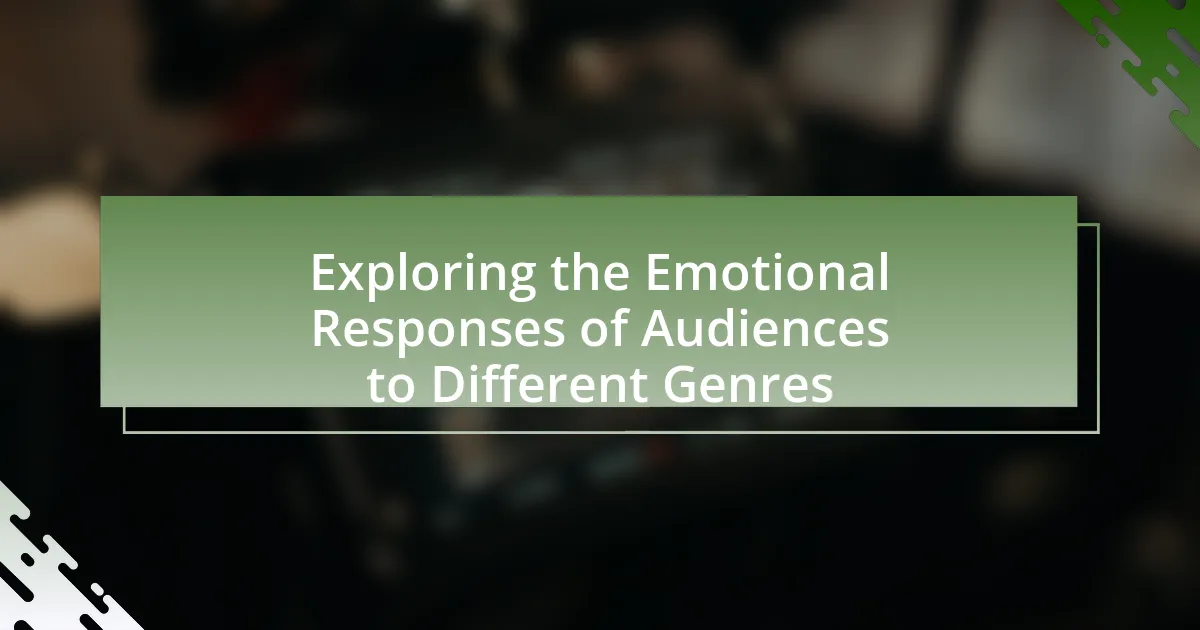The article examines audience perspectives on representation in film, highlighting the importance of authentic portrayals and diverse narratives. It discusses how representation influences audience perception, emotional responses, and engagement, as well as the historical context of representation in cinema. Key themes include the impact of stereotypes, demographic influences on audience views, and the evolving landscape of representation driven by audience demands for inclusivity. The article also explores how social media shapes discussions around representation and the role of audience feedback in influencing future film productions.
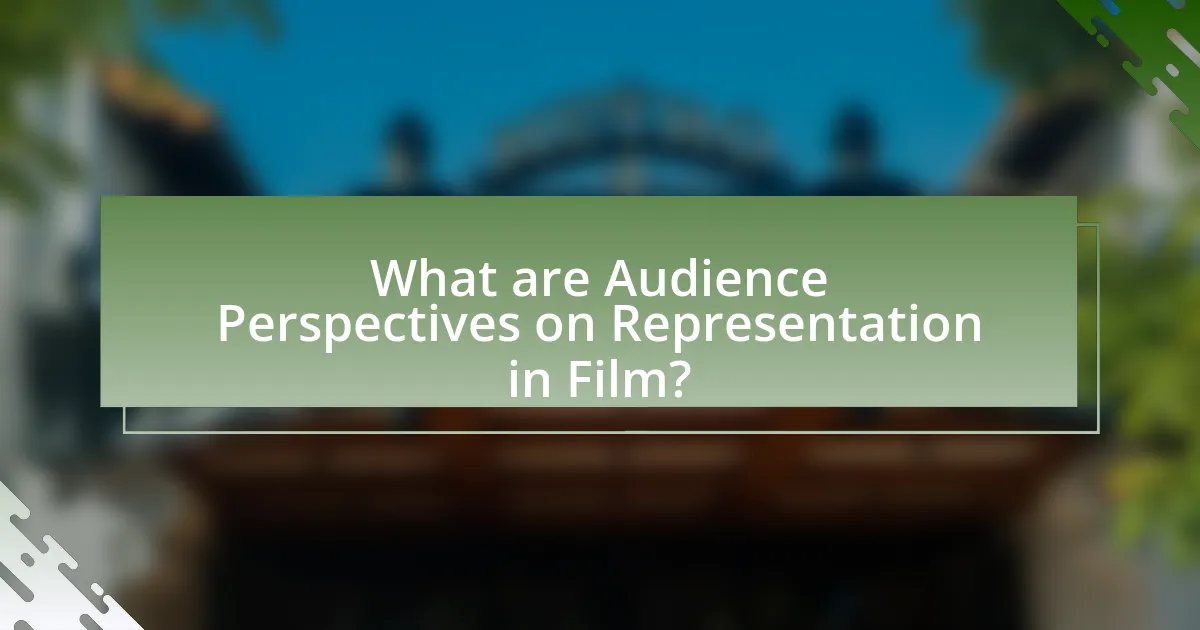
What are Audience Perspectives on Representation in Film?
Audience perspectives on representation in film vary significantly, reflecting diverse opinions on how accurately and fairly different groups are portrayed. Research indicates that audiences often seek authentic representation that resonates with their own experiences, leading to a demand for more inclusive storytelling. For instance, a study by the Geena Davis Institute on Gender in Media found that films with diverse casts and narratives tend to perform better at the box office, highlighting the commercial viability of representation. Additionally, surveys show that viewers are increasingly critical of stereotypes and demand more complex characters, which suggests that audience expectations are evolving towards a preference for nuanced portrayals that challenge traditional narratives.
Why is representation important in film?
Representation is important in film because it shapes societal perceptions and influences cultural narratives. Diverse representation allows audiences to see themselves reflected in stories, fostering a sense of belonging and validation. Studies, such as the 2019 report by the Annenberg Inclusion Initiative, reveal that films with diverse casts and crews tend to perform better at the box office, indicating that audiences respond positively to inclusive storytelling. Furthermore, representation can challenge stereotypes and promote understanding among different communities, contributing to social change and empathy.
How does representation influence audience perception?
Representation significantly influences audience perception by shaping how individuals understand and relate to characters and narratives. When diverse and accurate representations are present in film, they foster empathy and connection, allowing audiences to see themselves reflected in the stories being told. Research indicates that films featuring underrepresented groups can challenge stereotypes and broaden viewers’ perspectives, as demonstrated in studies like “The Impact of Representation on Audience Perception” by Smith et al., which found that audiences exposed to diverse characters reported increased understanding and acceptance of different cultures. Thus, representation not only affects individual perceptions but also contributes to broader societal attitudes and norms.
What are the historical contexts of representation in film?
The historical contexts of representation in film encompass the evolution of societal norms, cultural movements, and technological advancements that have influenced how various groups are depicted on screen. From the early 20th century, films often reflected prevailing stereotypes and social hierarchies, such as the portrayal of women and racial minorities, which were largely shaped by the cultural attitudes of the time. For instance, the Hays Code of the 1930s imposed strict guidelines that limited the representation of sexuality and race, reinforcing conservative values.
In the 1960s and 1970s, the civil rights movement and feminist movements prompted filmmakers to challenge these stereotypes, leading to more nuanced representations. The emergence of independent cinema in the 1990s further diversified narratives, allowing for authentic voices from marginalized communities. This shift is evidenced by films like “Do the Right Thing” (1989) by Spike Lee, which addressed racial tensions in America, and “Thelma & Louise” (1991), which explored female empowerment.
Overall, the historical contexts of representation in film reveal a dynamic interplay between societal changes and cinematic practices, illustrating how film has both shaped and reflected cultural perceptions over time.
How do different audiences perceive representation?
Different audiences perceive representation through the lens of their individual identities, experiences, and cultural backgrounds. For instance, marginalized groups often seek authentic portrayals that reflect their realities, while mainstream audiences may prioritize entertainment value over accuracy. Research indicates that representation in media can significantly impact self-esteem and social perceptions; a study by the Geena Davis Institute on Gender in Media found that 60% of girls who see female characters in leadership roles feel empowered to pursue similar paths. This highlights how diverse audience perspectives shape their understanding and expectations of representation in film.
What factors influence audience perspectives on representation?
Audience perspectives on representation are influenced by factors such as cultural background, personal experiences, and media exposure. Cultural background shapes individuals’ values and beliefs, which in turn affect how they interpret representations in film. Personal experiences, including identity and social interactions, further inform audience members’ expectations and reactions to diverse portrayals. Additionally, media exposure, including the frequency and context of viewing diverse representations, plays a crucial role in shaping perceptions. Research indicates that audiences who engage with a variety of media are more likely to develop nuanced understandings of representation, as evidenced by studies showing that increased exposure to diverse narratives correlates with greater empathy and acceptance of different identities.
How do demographics affect audience views on representation?
Demographics significantly influence audience views on representation by shaping individual experiences and cultural contexts. For instance, research indicates that younger audiences, particularly those aged 18-34, are more likely to prioritize diverse representation in media compared to older demographics, who may have different expectations based on their historical context. A study by the Geena Davis Institute on Gender in Media found that 50% of women and 40% of people of color reported feeling underrepresented in film, highlighting how demographic factors like gender and ethnicity directly impact perceptions of representation. Additionally, socioeconomic status can affect access to media and the types of narratives individuals resonate with, further diversifying audience perspectives on representation.
What are the common themes in audience discussions about representation?
Common themes in audience discussions about representation include diversity, authenticity, and the impact of stereotypes. Audiences frequently emphasize the importance of diverse characters and narratives that reflect a wide range of identities, as seen in the success of films like “Black Panther,” which showcased a predominantly Black cast and celebrated African culture. Authenticity is another critical theme, where viewers seek genuine portrayals that resonate with their experiences, as highlighted by the positive reception of films like “Moonlight,” which authentically depicted LGBTQ+ experiences. Additionally, discussions often critique the perpetuation of stereotypes, with audiences calling for more nuanced and complex representations that challenge traditional narratives, as evidenced by backlash against films that rely on one-dimensional characterizations.
What role do stereotypes play in audience perceptions?
Stereotypes significantly shape audience perceptions by influencing how individuals interpret characters and narratives in film. These preconceived notions can lead to biased evaluations, where audiences may accept or reject characters based on their alignment with societal stereotypes. Research indicates that when characters conform to stereotypes, audiences often experience a sense of familiarity, which can enhance engagement but may also perpetuate harmful biases. For instance, a study by Mastro and Greenberg (2000) found that exposure to stereotypical portrayals in media can reinforce existing stereotypes among viewers, affecting their attitudes and beliefs about different social groups. Thus, stereotypes play a crucial role in framing audience perceptions, often leading to oversimplified understandings of complex identities.
How do audiences respond to diverse casting choices?
Audiences generally respond positively to diverse casting choices, as it enhances representation and relatability in film. Research indicates that films featuring diverse casts often perform better at the box office, with a 2019 study by the USC Annenberg Inclusion Initiative revealing that films with ethnically diverse casts earned 29% more in box office revenue compared to those with predominantly white casts. Additionally, viewers express a greater emotional connection to stories that reflect a variety of backgrounds, leading to increased engagement and support for such films.
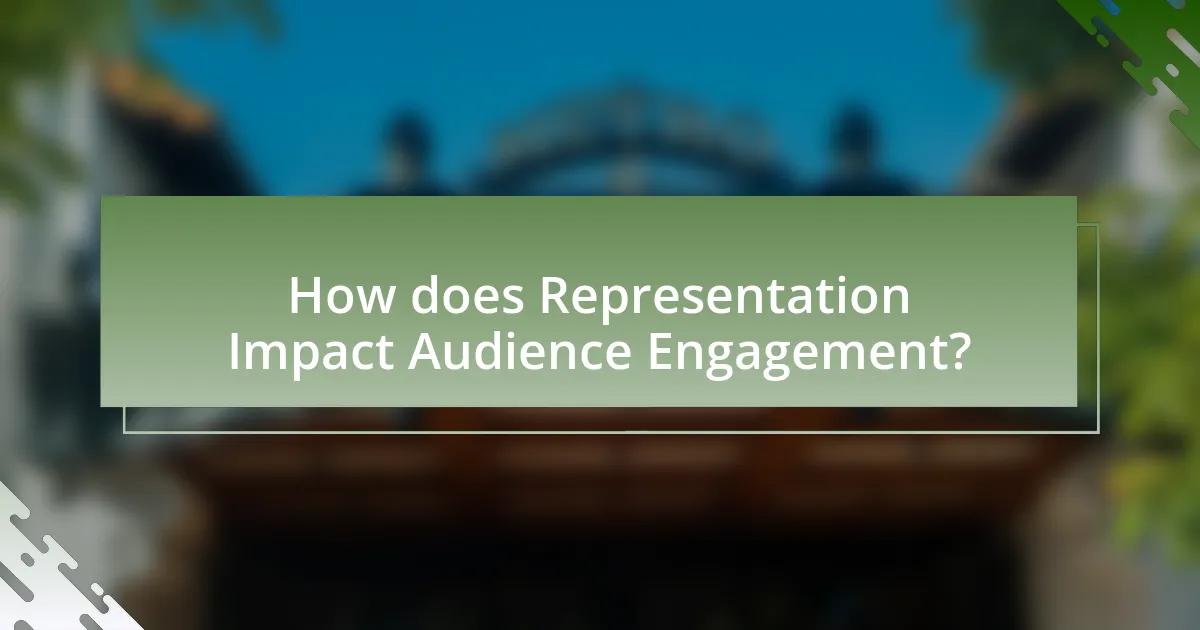
How does Representation Impact Audience Engagement?
Representation significantly impacts audience engagement by fostering a sense of connection and relatability among viewers. When diverse characters and narratives reflect the audience’s own experiences, backgrounds, and identities, it enhances emotional investment and encourages active participation. Research indicates that films featuring inclusive representation can lead to increased box office success; for instance, a study by the Geena Davis Institute on Gender in Media found that films with female leads performed better financially than those without. This correlation demonstrates that audiences are more likely to engage with content that resonates with their own identities, ultimately driving both viewership and discussion around the film.
What are the emotional responses of audiences to representation?
Audiences exhibit a range of emotional responses to representation, including validation, empathy, and sometimes discomfort. When individuals see characters that reflect their own identities, experiences, or struggles, they often feel validated, which can enhance their connection to the narrative. Research indicates that representation can foster empathy by allowing viewers to understand and relate to experiences outside their own, as demonstrated in studies like “The Effects of Media Representation on Audience Empathy” by Cohen and Strayer, which found that diverse representation in media increases empathetic responses among viewers. Conversely, misrepresentation or lack of representation can lead to feelings of alienation or frustration, as audiences may feel their identities are marginalized or stereotyped. This complex interplay of emotions underscores the significant impact that representation has on audience engagement and emotional investment in film narratives.
How does representation affect audience identification with characters?
Representation significantly affects audience identification with characters by influencing how relatable and authentic those characters appear to viewers. When characters reflect the diverse backgrounds, experiences, and identities of the audience, individuals are more likely to see themselves in those characters, fostering emotional connections. Research by Cohen and Harrison (2011) indicates that viewers who identify with characters are more engaged and invested in the narrative, leading to a deeper emotional response. Furthermore, representation can challenge stereotypes and broaden perspectives, allowing audiences to empathize with experiences outside their own, thus enhancing identification.
What are the implications of representation on audience loyalty?
Representation significantly influences audience loyalty by fostering a sense of connection and relatability. When audiences see themselves or their experiences reflected in film, they are more likely to develop an emotional attachment to the content, leading to increased loyalty. Research indicates that diverse representation can enhance viewer engagement; for instance, a study by the Geena Davis Institute on Gender in Media found that films with strong female characters tend to perform better at the box office, indicating that audiences are more loyal to narratives that resonate with their identities. This connection not only drives repeat viewership but also encourages positive word-of-mouth, further solidifying audience loyalty.
How do audiences react to films with poor representation?
Audiences typically react negatively to films with poor representation, often expressing disappointment and frustration. Research indicates that viewers are increasingly aware of and sensitive to issues of representation, leading to vocal criticism on social media and review platforms. For instance, a study by the Geena Davis Institute on Gender in Media found that 67% of women and 58% of men believe that media representation affects societal perceptions of gender roles. This awareness can result in decreased box office performance and calls for accountability from filmmakers, as audiences demand more authentic and diverse portrayals.
What are the consequences of negative representation on audience reception?
Negative representation significantly impacts audience reception by fostering stereotypes and reinforcing biases. Audiences exposed to negative portrayals may develop skewed perceptions of the represented group, leading to increased prejudice and discrimination. Research indicates that consistent exposure to negative media representations can diminish empathy and understanding, as seen in studies like “The Effects of Media Representations on Stereotyping” by Mastro and Greenberg, which found that negative portrayals correlate with negative attitudes towards minority groups. Furthermore, negative representation can alienate audiences from the media, resulting in disengagement and a lack of identification with the content, ultimately affecting viewership and cultural discourse.
How do audiences express dissatisfaction with representation in film?
Audiences express dissatisfaction with representation in film through various means, including social media criticism, organized protests, and petitions. For instance, the #OscarsSoWhite movement highlighted the lack of diversity in Academy Award nominations, prompting widespread discussions about racial representation in Hollywood. Additionally, viewers often leave negative reviews on platforms like Rotten Tomatoes or IMDb, where they articulate their concerns about stereotypical portrayals or the absence of certain demographics. These actions reflect a growing awareness and demand for more authentic and diverse narratives in the film industry.
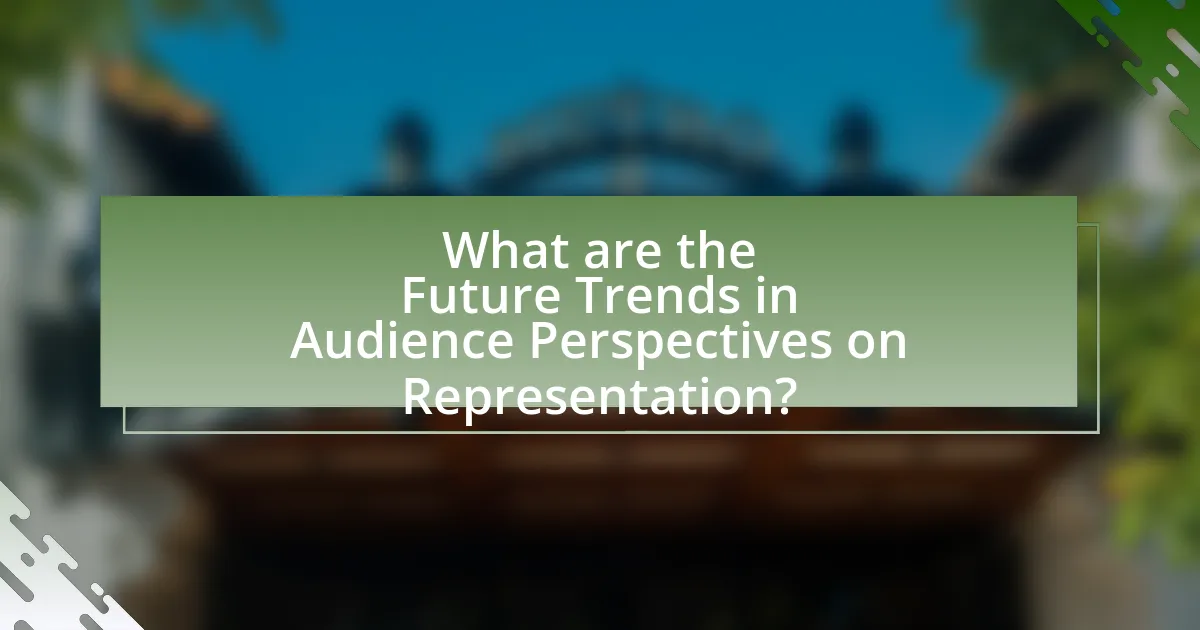
What are the Future Trends in Audience Perspectives on Representation?
Future trends in audience perspectives on representation indicate a growing demand for authenticity and diversity in media. Audiences increasingly expect films to reflect a wide range of identities, including race, gender, sexual orientation, and disability, as evidenced by studies showing that 67% of viewers prefer content that portrays diverse characters and stories. This shift is driven by younger demographics, particularly Gen Z, who prioritize inclusivity and representation in their media consumption. Furthermore, social media platforms amplify audience voices, leading to greater accountability for filmmakers and studios to address representation issues. As a result, the film industry is likely to see an increase in projects that prioritize authentic storytelling and diverse casting, aligning with audience expectations for more representative narratives.
How is the landscape of representation evolving in film?
The landscape of representation in film is evolving towards greater inclusivity and diversity, reflecting a broader range of identities and experiences. This shift is evidenced by the increasing number of films featuring protagonists from underrepresented groups, such as women, people of color, and LGBTQ+ individuals. For instance, the success of films like “Black Panther” and “Crazy Rich Asians” demonstrates a growing acceptance and demand for diverse narratives, leading to a significant increase in box office revenue and audience engagement. Additionally, industry initiatives, such as the inclusion rider and diversity quotas, are being implemented to ensure equitable representation both in front of and behind the camera. This evolution is supported by research from the USC Annenberg Inclusion Initiative, which highlights that films with diverse casts tend to perform better financially, indicating that audiences are increasingly seeking authentic representation in cinema.
What role does social media play in shaping audience perspectives?
Social media significantly influences audience perspectives by facilitating the rapid dissemination of information and diverse viewpoints. Platforms like Twitter and Instagram allow users to share opinions, experiences, and critiques related to films, which can shape public perception and discussion. For instance, a study by the Pew Research Center found that 69% of adults in the U.S. use social media, making it a powerful tool for shaping narratives around representation in film. This widespread engagement enables audiences to challenge traditional media portrayals and advocate for more inclusive representation, thereby altering collective attitudes and expectations regarding film content.
How are filmmakers responding to audience demands for better representation?
Filmmakers are increasingly responding to audience demands for better representation by diversifying their storytelling and casting practices. This shift is evident in the rise of films and series that feature underrepresented groups, such as people of color, LGBTQ+ individuals, and women in leading roles. For instance, the success of films like “Black Panther” and “Crazy Rich Asians” demonstrates that audiences are eager for narratives that reflect diverse experiences, leading studios to prioritize inclusive projects. Additionally, industry initiatives, such as the inclusion rider, aim to ensure equitable representation both in front of and behind the camera, further validating the audience’s call for change.
What can audiences do to advocate for better representation in film?
Audiences can advocate for better representation in film by actively supporting diverse films and creators. By choosing to watch, promote, and discuss films that feature underrepresented groups, audiences can signal to studios the demand for inclusive storytelling. Research indicates that films with diverse casts and narratives often perform better at the box office, demonstrating that there is a market for such content. For instance, a 2020 study by the USC Annenberg Inclusion Initiative found that films with diverse representation not only attract wider audiences but also receive higher critical acclaim. Engaging in conversations on social media and participating in campaigns that call for diversity in casting and storytelling further amplifies audience voices, influencing industry practices.
What strategies can audiences employ to support diverse storytelling?
Audiences can support diverse storytelling by actively seeking out and consuming media that features underrepresented voices and perspectives. This includes watching films and shows created by diverse filmmakers, reading books by authors from various backgrounds, and engaging with content that explores different cultures and experiences. Research indicates that diverse representation in media not only enriches storytelling but also fosters empathy and understanding among viewers, as highlighted in the 2019 study by the Geena Davis Institute on Gender in Media, which found that inclusive narratives positively impact audience perceptions and attitudes. By prioritizing diverse content, audiences can contribute to a broader cultural dialogue and encourage the industry to invest in varied storytelling.
How can audience feedback influence future film productions?
Audience feedback can significantly influence future film productions by guiding creative decisions and marketing strategies. Filmmakers often analyze audience reactions to gauge what resonates, leading to adjustments in storytelling, character development, and thematic focus. For instance, the success of films like “Black Panther” demonstrated that audiences value representation, prompting studios to invest more in diverse narratives. Additionally, box office performance and social media sentiment provide quantifiable data that can shape future projects, ensuring they align with audience expectations and preferences.
